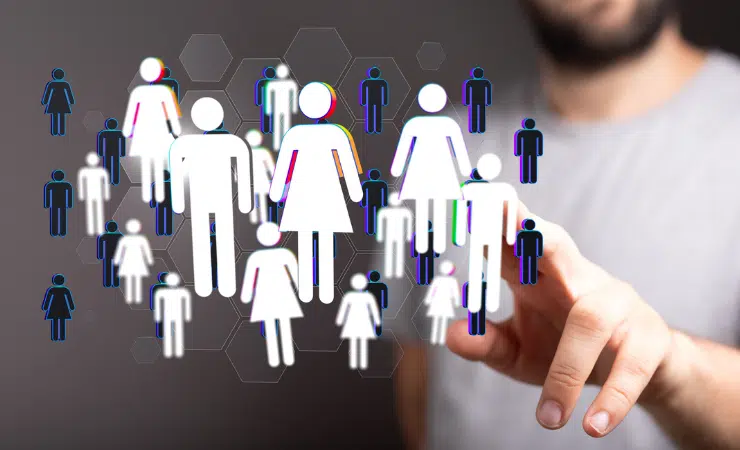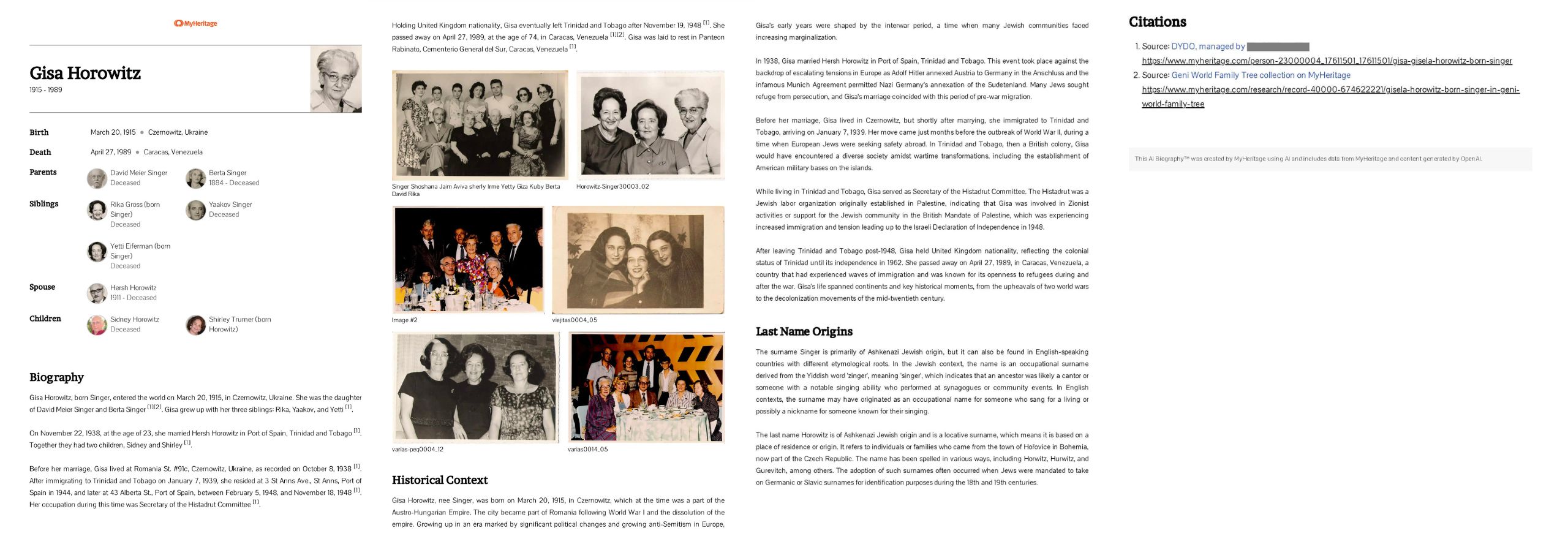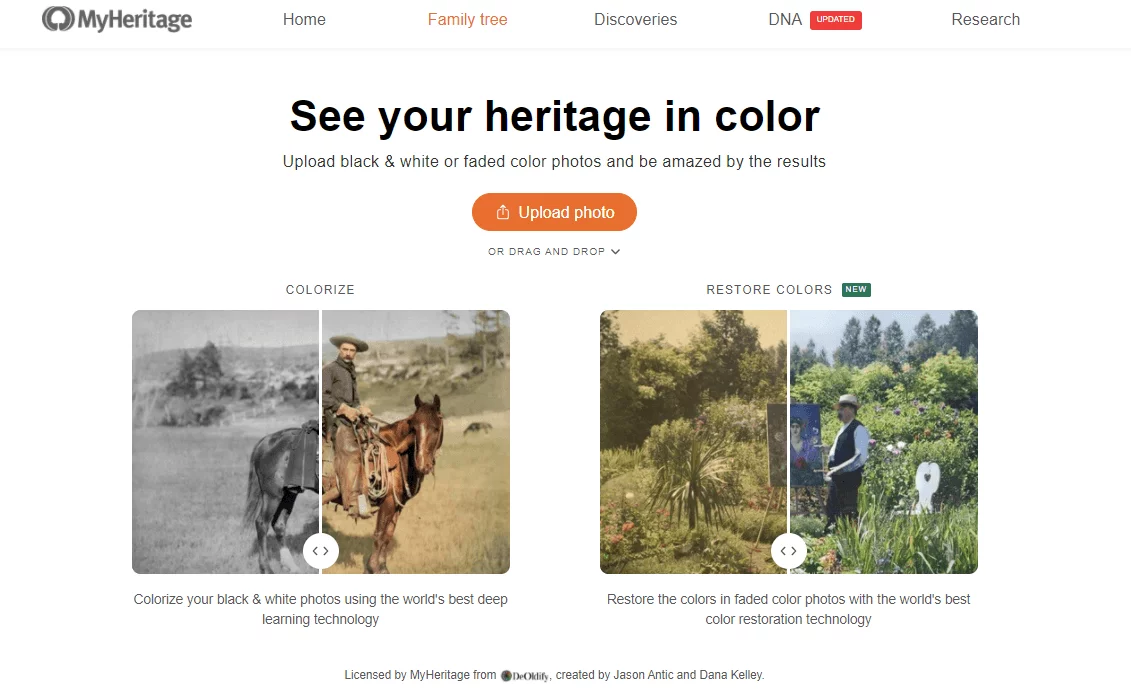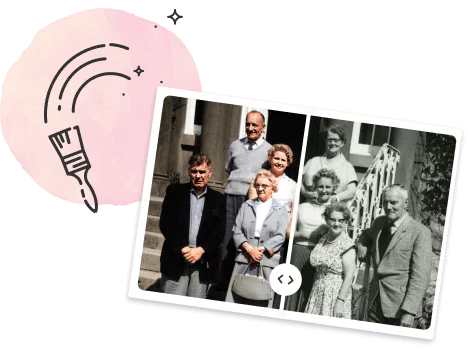
While AI (artificial intelligence) might be the current “hot” buzz word, the fact is that many genealogy vendors and even genealogists have already been using this technology for years. The AI industry is at a crossroads and within the next five years, it will permeate almost every aspect of business and society including genealogical research. Learn how AI is currently being used by MyHeritage to improve the genealogy experience.
What is AI?
AI stands for Artificial Intelligence and represents computer-based systems that can “mimic” human intelligence. The goal is to have these systems perform human tasks.
A task could be as simple as entering a customer service-related question on a company’s website and having AI generate a response. Now that might appear like simple stuff — the computer just “looks up” a response and posts it to the chat panel. But AI-based systems might prompt you with more questions in order to generate the most helpful answer. And the system could capture your questions and “learn” more about the way you use the product in order to better respond in the future.
The most discussed features of artificial intelligence are “deep learning” and “generative AI.” Deep learning mimics the human brain in that it looks for patterns using vast amounts of information to interpret photos, audio, and text. Generative AI actually “generates” new photos, audio, and text, based on information provided by the user, and again, uses its own database of “training data” to understand patterns and generate output that matches the user’s query.
AI platforms
While genealogy vendors such as MyHeritage are incorporating artificial intelligence into the features they provide to users, there are some popular AI platforms open to the public that you might want to consider using.
- Bard: Developed by Google, Bard (https://bard.google.com/) describes itself more as a conversational chatbot that can “generate text, translate languages, write different kinds of creative content, and answer your questions in an informative way.” Bard is the main competitor to the ChatGPT platform.
- ChatGPT: Meaning “Chat Generative Pre-trained Transformer,” ChatGPT (https://chat.openai.com/) is the most popular publicly-accessible artificial intelligence platform.
- Perplexity: A relative newcomer in the world of AI platforms, Perplexity (https://www.perplexity.ai/) presents a curated list of sources when answering user queries.
Current uses of AI for genealogy
Believe it or not, genealogists have already benefited from artificial intelligence, whether it is just spelling and grammar check in Microsoft Word when writing a family story or genealogical report, or searching for family in the 1950 United States Census — which was indexed using artificial intelligence’s ability to decipher handwriting.
- Family photos: MyHeritage has been offering a variety of photo enhancement tools over the past three years including ways to colorize images and make them clearer. In addition there are tools that can “animate” an ancestor based on a photo and even help determine the date of an image based on characteristics such as fashion styles, hair styles, and more. The new Reimagine app offers all these tools in one convenient platform.
- Transcription: The National Archives and Records Administration (NARA) utilized artificial intelligence to index the 1950 U.S. Census population schedules released in April 2022. Entries made by enumerators were scanned and transcribed, then released for use at a much faster rate than what was accomplished with manual indexing performed for the 1940 U.S. Census release in 2012. For the 1950 U.S. Census, users were encouraged to review the transcriptions and submit corrections as part of a community effort by genealogists and other researchers.
- Suggesting records: MyHeritage lists “suggested” records in the sidebar of the page when viewing a record as part of a search. In addition, Smart Matches™ and Record Matches will often pop up in the family tree suggesting records and other family trees that a researcher might want to review due to similarities in data.
- DNA matches: With millions of people having used personal DNA testing kits, MyHeritage is able to leverage AI to find connections between testers based on shared DNA data. Given the sheer amount of information involved, these match results are only possible with artificial intelligence.
AI and source citations
Those new to genealogy and family history soon learn the importance of source citations in proving relationships as well as facts about an ancestor. Usually source citations document how we find and use records such as census population schedules, death certificates, and even letters or diaries.
For the most part, you won’t find records when making queries on an AI platform. But you may find information that serves as a clue for further research or, more likely, as social history about how an ancestor lived. In these situations, a method of citing AI-generated content is needed.
Citing sources need not be intimidating or time consuming. Stick to the basics: the information found, how it was found, information about where it was found, and locator data so another researcher can find the information.
For artificial intelligence content, here’s the formula you might consider using as proposed by the Modern Language Association of America (MLA):
“[QUERY]” prompt. [NAME OF AI PLATFORM], [DATE OR VERSION OF PLATFORM], [NAME OF AI COMPANY], [DATE OF QUERY], [PLATFORM URL]
So, if I asked Bard to determine the value of my great-grandfather’s home in the 1930 US Census listed as $80,000 in 2023 dollars, here is the source citation I would use:
“Value of home in the 1930 US Census listed as $80,000 in 2023 dollars” prompt. ChatGPT, Version 3.5, OpenAI, 1 October 2023, https://chat.openai.com/
MyHeritage features using artificial intelligence
While many genealogy platforms have incorporated artificial intelligence into their features, MyHeritage has led the way in new and innovative uses of AI for family history research.
Here’s what you can do with MyHeritage’s AI features:
Create a Wikipedia-style biography of an ancestor with AI Biographer™: AI Biographer™ uses generative AI to create a detailed article on an ancestor of your choice drawing upon information from the family tree and incorporating additional information from historical records and other family trees as well as historical context from the web. Each AI Biography™ includes source citations and photographs. You can create an AI Biography™ from the profile panel of any deceased ancestor with enough basic information in your family tree. Learn more here.

Colorize, enhance, repair, and animate photos with the MyHeritage photo features: MyHeritage’s smart photo features are based on deep learning AI. They include:
- Photo Repair: a feature that automatically fixes scratches, tears, holes, stains and other damage on historical photos. What a great feature and time saver! Many family historians struggle using other programs like Adobe Photoshop to remove lines and creases as well as fix tears in photos. With Photo Repair’s one button fix, you can improve the quality of your photos quickly and with amazing results.
- Photo Enhancer: a feature that improves the quality of photos and brings blurry faces into sharp focus. Let’s face it, we all have family photos taken by a family member that weren’t exactly in focus. Photo Enhancer produces amazing results with just one click. The clarity is outstanding and it can help you see new details in a photo that you may have missed.
- MyHeritage In Color™: an automatic photo colorization and color restoration tool that breathes life and color into old family photos. Ever wonder the exact color of that dress your grandmother wore to a party? Or what street life really looked like where your ancestors lived? MyHeritage In Color™ can help you visualize the original colors of a family photo, again with just one click. No need for other color restoration software or sites.
- Deep Nostalgia™: a one-of-a-kind feature that allows you to animate the faces in your old family photos. We all have relatives and ancestors we’ve never met. Animating their faces using Deep Nostalgia™ is a great way to see how ancestors may have moved and reacted.
And a nice aspect of using these photo tools? The ability to delete the altered photo and keep the original! Learn more about the MyHeritage photo features here.

Let your ancestors tell their own stories with DeepStory: Create an animated video based on photos and details from your family tree on MyHeritage. Using AI, DeepStory also adds speaking audio to produce a narrative about an ancestor’s life. Learn more here.
Transport yourself to another era with AI Time Machine™: Ever wanted to see what you would look like as a Celtic warrior or Roman aristocrat? AI Time Machine™ leverages the power of AI using uploaded photos to produce amazing avatars allowing you to travel through history. Learn more here and in the video below:
Estimate the dates photos were taken with PhotoDater™: a feature that uses AI to estimate the date of a photo based on clothing, hairstyles, background objects and more. With an estimated date you can then unlock further clues about an ancestor or an event shown in the photo. Learn more here.
AI: The Good and the Bad
With all the “hype” about artificial intelligence, it can be difficult to figure out not only what is true about this technology, but also the benefits and drawbacks. Here is an explanation of the elements of AI that have impacted or will impact how we search for ancestors.
The Good
There seem to be endless possibilities for using artificial intelligence when searching for ancestors. This makes for an exciting time to be doing genealogy.
- Analyzing vast amounts of data: Yes, there is a lot of information available online for genealogy research, but humans cannot possibly analyze that information as quickly as artificial intelligence. This allows for discovering new connections between data points and better understanding migration patterns and motivations, F.A.N. club relationships, the impact of social history on our ancestors, and more. What is not obvious immediately to our human minds can be quickly determined by using artificial intelligence.
- Translation and transcription: As already demonstrated with the release of the 1950 U.S. Census images, AI promises to make the transcription and translation of record images faster and easier. I recently uploaded a newspaper clipping from a historical newspaper that has not yet been digitized, and the AI platform did an amazing job transcribing the content.
- Timelines and mapping: For those genealogists who want to fill in the “dash” between an ancestor’s birth date and death date, artificial intelligence can help build complex timelines as well as “map” event dates to locations for a better understanding of how our ancestors lived.
The Bad
While many see artificial intelligence as a panacea that can cure many problems that come with genealogical research, AI can also be a Pandora’s box filled with its own set of problems.
- Lack of transparency: One of the biggest issues for users of AI is the inability of the user to determine the source of the reference material used when generating content. Another issue is recognizing AI-generated content. Most users are not adding source citations to AI-generated content or watermarks to AI-generated images.
- Bias: Studies have proven that many AI platforms can be biased, especially since content used as reference material is supplied by humans. The same biases we see in terms of race, gender, and age are easily replicated by artificial intelligence. Recent examples have included a bias towards generating white or caucasian faces rather than people of color when asked to create certain types of images.
- Copyright: Many copyright and intellectual property issues related to AI have popped up in the past year. U.S. courts have ruled that content created by artificial intelligence cannot be copyrighted. In addition, several content creators including authors and performers have sued major AI platforms such as ChatGPT and Bard for scraping copyright-protected content from the internet to help create AI-generated content.
- False information: As platforms using AI gather information, who or what is determining what is true and what is false? A recent example of a law firm submitting a legal filing created by artificial intelligence — resulting in a list of fictitious court cases to support legal arguments — demonstrates the problem. This is another reason that “human review” is often required before relying upon AI-generated content.
- High costs: While not often discussed, deploying artificial intelligence can be expensive for vendors, resulting in higher prices for the genealogy consumer. The machines and servers used for AI processes require more powerful chips as well as simply just more power to run. Besides an increase in costs, there are environmental and climate impact costs through the need for more energy to power AI computers.
Future uses of AI for genealogy
The concern over artificial intelligence in general, and specifically in family history research, is similar to the concern over social media almost 15 years ago. Remember when genealogists were worried about Facebook and X (formerly known as Twitter)?
We are experiencing the “First Phase” of using artificial intelligence when it comes to genealogy and family history research. Five years from now we should be in “Second Phase” mode. What does this mean?
Remember when Netscape was THE BROWSER everyone used when the Internet became popular in the early 1990s? And MYSPACE was THE SOCIAL MEDIA PLATFORM? Well, the second-phase apps — Google and Facebook respectively — are now the most popular. The second phase of a new technology usually brings vast improvements in terms of functionality, ease-of-use, and value.
Here’s a short list of what you can expect to see in the next five years:
- DNA triangulation tools that will quickly determine relationships on family trees.
- Conversion of handwriting into searchable text including older forms of English and German handwriting.
- Creation of source citations for a variety of records using specific formats such as MLA, Evidence Explained, and AP style.
- Discovering connections between F.A.N. club members using digitized historical newspapers content and other records.
- Identification of ancestors in old family photos based on “traits” such as facial features including connecting family members based on similar traits.
- Suggesting records for expanding genealogical searches including those records not yet digitized.
Conclusion
Artificial intelligence is seen as powerful but also as something to be feared. It isn’t much different than how our earliest ancestors reacted to the discovery of fire. That new technology had great benefits and advanced progress in many areas of human life. But fire also brought new dangers and uses that might not have been anticipated.
The best way to cut through the current hype and misinformation around AI is to stay informed. Learn from other genealogists how they are using artificial intelligence to improve their genealogy research.
Whether you decide to take a full plunge or just dip your toe in the AI pond, you’ll discover amazing possibilities and ways to take your search for your roots to the next level.





